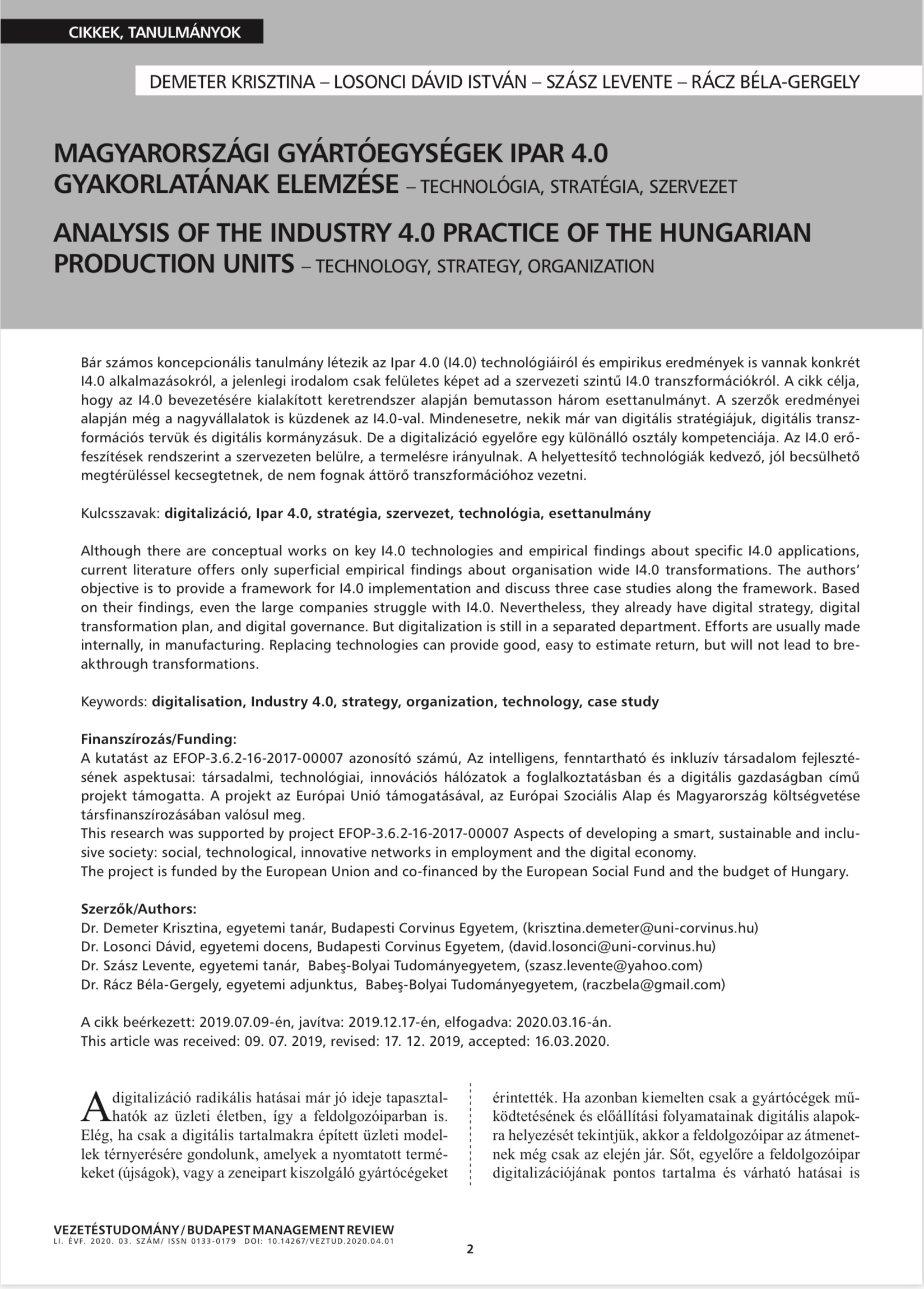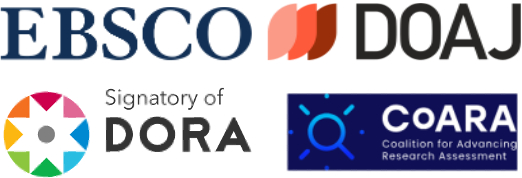Magyarországi gyártóegységek ipar 4.0 gyakorlatának elemzése
Technológia, stratégia, szervezet
DOI:
https://doi.org/10.14267/VEZTUD.2020.04.01Kulcsszavak:
digitalizáció, Ipar 4.0, stratégia, szervezet, technológia, esettanulmányAbsztrakt
Bár számos koncepcionális tanulmány létezik az Ipar 4.0 (I4.0) technológiáiról és empirikus eredmények is vannak konkrét I4.0 alkalmazásokról, a jelenlegi irodalom csak felületes képet ad a szervezeti szintű I4.0 transzformációkról. A cikk célja, hogy az I4.0 bevezetésére kialakított keretrendszer alapján bemutasson három esettanulmányt. A szerzők eredményei alapján még a nagyvállalatok is küzdenek az I4.0-val. Mindenesetre, nekik már van digitális stratégiájuk, digitális transzformációs tervük és digitális kormányzásuk. De a digitalizáció egyelőre egy különálló osztály kompetenciája. Az I4.0 erőfeszítések rendszerint a szervezeten belülre, a termelésre irányulnak. A helyettesítő technológiák kedvező, jól becsülhető megtérüléssel kecsegtetnek, de nem fognak áttörő transzformációhoz vezetni.
Letöltések
Hivatkozások
Acemoglu, D. (2016). The Impact of IT on the Labor Market. US: Massachusetts Institute of Technology. Retrieved from https://economics.mit.edu/files/12118
Acemoglu, D. (2017. May). Automation and the future of jobs. Toulouse Network for Information Technology (TNIT News). Toulouse: Toulouse School of Economics. Retrieved from https://idei.fr/sites/default/files/IDEI/documents/tnit/newsletter/issue_17.pdf
Andersson, H., & Tuddenham, P. (2014). Reinventing IT to support digitization. New York: McKinsey.
Baker, J. (2012). The technology–organization–environment framework. In Information Systems Theory ( pp. 2 31-245). New York, NY: Springer.
Báthory, Z. (2020). Az értékáram alapú szervezet empirikus vizsgálata öt magyarországi termelő üzem példáján keresztül. Vezetéstudomány, 51(3), 2-16. https://doi.org/10.14267/VEZTUD.2020.03.01
Brettel, M., Friederichsen, N., Keller, M., & Rosenberg, M. (2014). How Virtualization, Decentralization and Network Building Change the Manufacturing Landscape: An Industry 4.0 Perspective. International Scholarly and Scientific Research & Innovation, 8(1), 37-44.
Buer, S.-V., Strandhagen, J. O., & Chan, F. T. (2018). The link between Industry 4.0 and lean manufacturing: mapping current research and establishing a research agenda. International Journal of Production Research, 56(8), 2924-2940. https://doi.org/10.1080/00207543.2018.1442945
Carpenter, H. (2009). Gartner Hype Cycle for Emerging Technologies 2009: What’s Peaking, What’s Troughing?
Retrieved from https://bhc3.com/2009/07/27/gartnerhype-cycle-2009-whats-peaking-whats-troughing/
Chen, Y. S., Chang, C. H., & Wu, F. S. (2012). Origins of green innovations: the differences between proactive and reactive green innovations. Management Decision, 50(3), 368-398. https://doi.org/10.1108/00251741211216197
Cséfalvay, Z. (2017). A nagy korszakváltás. Budapest: Kairosz Kiadó.
Davies, R. (2015). Industry 4.0 Digitalisation for productivity and growth. European Union: European Parliamentary Research Service, European Parlaiment. Retrieved from http://www.europarl.europa.eu/RegData/etudes/BRIE/2015/568337/EPRS_BRI(2015)568337_EN.pdf
De Toni, A., & Tonchia, S. (1996). Lean organization, management by process and performance measurement. International Journal of Operations & Production Management, 16(2), 221-236. https://doi.org/10.1108/01443579610109947
Demeter, K., Losonci, D., Nagy, J., & Horváth, B. (2019). Tapasztalatok az Ipar 4.0-val – egy esetalapú elemzés. Vezetéstudomány, 50(4), 11-23. https://doi.org/10.14267/VEZTUD.2019.04.02
Donaldson, L. (2001). The Contingency Theory ofOrganizations. Thousand Oaks, California: Sage Publications.
Fettermann, D. C., Sá Cavalcante, C. G., de Almeida, T. D., & Tortorella, G. L. (2018). How does Industry 4.0 contribute to operations management?, Journal of Industrial and Production Engineering, 35(4), 255-268. https://doi.org/10.1080/21681015.2018.1462863
Galbraith, J. R. (2010). The multi-dimensional and reconfigurable organization. CEO Publication T10-06 (574). Retrieved from https://ceo.usc.edu/files/2016/10/2010_06-t10_06-Multi_Dimensional_Reconfigurable_Org.pdf
Gartner (n.d.). Gartner Hype Cycle. Retrieved from https://www.gartner.com/en/research/methodologies/gartner-hype-cycle
Gartner, I. (2013). Gartner's 2013 Hype Cycle for Emerging Technologies Maps Out Evolving Relationship BetweenHumans and Machines. Retrieved from https://www.gartner.com/technology/pressRoom.do?id=2575515
Gauger, C., Gehres, B., Quinn, M., Schmieg, F., & Xu, G. (2017). Building the digital car company of the future. USA: The Boston Consulting Group.
Geissbauer, R., Vedso, J., & Schrauf, S. (2016). Industry 4.0: Building the digital enterprise. Retrieved from https://www.pwc.com/gx/en/industries/industries-4.0/landingpage/industry-4.0-building-your-digital-enterpriseapril-2016.pdf
Ghobakhloo, M. (2018). The future of manufacturing industry: a strategic roadmap toward Industry 4.0. Journal of Manufacturing Technology Management, 29(6), 910-936. https//doi:10.1108/JMTM-02-2018-0057
Gilchrist, A. (2016). Industry 4.0: the industrial internet of things. New York, NY: Apress.
Goran, J., LaBerge, L., & Srinivasan, R. (2017). Culture for a digital age. McKinsey&Company. Retrieved from https://www.mckinsey.com/business-functions/digitalmckinsey/our-insights/culture-for-a-digital-age
Horlacher, A., & Hess, T. (2016). What Does a Chief Digital Officer Do? Managerial Tasks and Roles of a New C-level Position in the Context of Digital Transformation. IEEE Computer Society, 49th Hawaii International Conference on System Sciences, 5126-5135. https://doi.org/10.1109/HICSS.2016.63
Horváth, D., & Szabó, Z. R. (2019). Driving forces and barriers of Industry 4.0: Do multinational and small and medium-sized companies have equal opportunities?Technological Forecasting and Social Change, 146, 119-132. https://doi.org/10.1016/j.techfore.2019.05.021
Horváth, D., Móricz, P., & Szabó, Z. R. (2018). Üzletimodellinnováció. Vezetéstudomány, 49(6), 2-12. https://doi.org/10.14267/VEZTUD.2018.06.01
King, W. R., & Teo, T. S. (2000). Assessing the impact of proactive versus reactive modes of strategic information systems planning. Omega, 28(6), 667-679. https://doi.org/10.1016/S0305-0483(99)00079-1
Kotha, S., & Swamidass, P. M. (2000). Strategy, advanced manufacturing technology and performance: empirical evidence from US manufacturing firms. Journal of Operations Management, 18(3), 257-277. https://doi.org/10.1016/S0272-6963(99)00025-X
Lasi, H., Fettke, P., Kemper, H.-G., Feld, T., & Hoffmann, M. (2014). Industrie 4.0. Business and Information Systems Engineering, 6(4), 239-242. https://doi.org/10.1007/s11576-014-0424-4
Legner, C., Eymann, T., Hess, T., Matt, C., Böhmann, T., Drews, P., & Ahlemann, F. (2017). Digitalization: opportunity and challenge for the business and information systems engineering community. Business & Information Systems Engineering, 59(4), 301-308. https://doi.org/10.1007/s12599-017-0484-2
Leonard-Barton, D. (1990). A dual methodology for case studies: Synergistic use of a longitudinal single site with replicated multiple sites. Organization Science, 1(3), 248-266. https://doi.org/10.1287/orsc.1.3.248
Lewis, M. W., & Boyer, K. K. (2002). Factors impacting AMT implementation: an integrative and controlled study. Journal of Engineering and Technology Management, 19(2), 111-130. https://doi.org/10.1016/S0923-4748(02)00005-X
López-Gómez, C., McFarlane, D., O’Sullivan, E., & Velu, C. (2018. szeptember). The practical impact of digital manufacturing: results from recent international experience. Interim Report. Cambridge, United
Kingdom: Policy Links, Institute for Manufacturing (IfM), University of Cambridge. Retrieved from https://www.ifm.eng.cam.ac.uk/uploads/Content_Images/IfM_IUK_Interim_revised.PDF
Losonci, D., Takács, O., & Demeter, K. (2019). Az Ipar 4.0 hatásainak nyomában – a magyarországi járműipar példáján. Közgazdasági Szemle, 66(2), 185-218. https://doi.org/10.18414/KSZ.2019.2.185
Lucianetti, L., Jabbour, C. J., Gunasekaran, A., & Latan, H. (2018). Contingency factors and complementary effects of adopting advanced manufacturing tools and managerial practices: Effects on organizational measurement systems and firms' performance. International Journal of Production Economics, 200, 318-328. https://doi.org/10.1016/j.ijpe.2018.04.005
McKinsey&Company. (2016). Industry 4.0 at McKinsey’s model factories – Get ready for the disruptive wave. McKinsey & Company, Inc. Retrieved from https://capability-center.mckinsey.com/files/mccn/2017-03/digital_ 4.0_model_factories_brochure_2.pdf
Miel, R. (2018). CASE, ACES or SAEV: What will we call electric, shared self-driving cars? Automotive News. Retrieved from https://www.autonews.com/article/20180731/MOBILITY/180739890/case-aces-orsaev-what-will-we-call-electric-shared-self-drivingcars
Mintzberg, H., & Waters, J. A. (1985). Of strategies, deliberate and emergent. Strategic Management Journal 6(3), 257-272. https://doi.org/10.1002/smj.4250060306
Nagy, J. (2019). Az ipar 4.0 fogalma és kritikus kérdései – vállalati interjúk alapján. Vezetéstudomány, 50, 1, 14-26. https://doi.org/10.14267/VEZTUD.2019.01.02
Netland, T. (2013). Exploring the phenomenon of companyspecific production systems. International Journal of Production Research, 51(4), 1084–1097. https://doi.org/10.1080/00207543.2012.676686
O'Regan, N., & Ghobadian, A. (2002). Formal strategic planning: the key to effective business process management? Business Process Management Journal, 8(5), 416-429. https://doi.org/10.1108/14637150210449102
Panetta, K. (2018). 5 Trends Emerge in the Gartner Hype Cycle for Emerging Technologies, 2018. Retrieved from https://www.gartner.com/smarterwithgartner/5-trends-emerge-in-gartner-hype-cycle-for-emergingtechnologies-2018/
Pires, G. D., & Aisbett, J. (2003). The relationship between technology adoption and strategy in business-tobusiness markets: the case of e-commerce. Industrial Marketing Management, 32(4), 291-300. https://doi.org/10.1016/S0019-8501(02)00237-7
Porter, M. E., & Heppelmann, J. E. (2014). How smart, connected products are transforming competition. Harvard Business Review, 92(11), 64-88.
Roland Berger (2016). Digital factories – The renaissance of the U.S. automotive industry. Munich, Germany: Roland Berger. Retrieved from https://www.rolandberger.com/publications/publication_pdf/roland_berger_tab_digital_factories_20160217.pdf
Schlechtendahl, J., Keinert, M., Kretschmer, F., Lechler, A.,& Verl, A. (2015). Making existing production systems Industry 4.0-ready. Production Engineering, 9(1), 143-148. https://doi.org/10.1007/s11740-014-0586-3
Schwab, K. (2016). The Fourth Industrial Revolution. London: Portfolio Penguin.
Slack, N., Chambers, S., & Johnston, R. (2010). Operations management. Harlow: Prentice Hall, Financial Times.
Sousa, R., & Voss, C. A. (2008). Contingency research in operations management practices. Journal of Operations Management, 26(6), 697-713. https://doi.org/10.1016/j.jom.2008.06.001
Stock, G. N., & McDermott, C. M. (2001). Organizational and strategic predictors of manufacturing technology implementation success: an exploratory study. Technovation, 21(10), 625-636. https://doi.org/10.1016/S0166-4972(01)00051-7
Szabó, Z. R., Horváth, D., & Hortoványi, L. (2019). Hálózati tanulás az ipar 4.0 korában. Közgazdasági Szemle, 66(1), 72-94. https://doi.org/10.18414/KSZ.2019.1.72
Tornatzky, L., & Fleischer, M. (1990). The process of technology innovation. Lexington, MA: Lexington Book.
Valenduc, G., & Vendramin, P. (2016). Work in the digital economy: sorting the old from the new. ETUI, Brussels. Retrieved from https://www.etui.org/Publications2/Working-Papers/Work-in-the-digital-economy-sortingthe-old-from-the-new
Viharos, Z., Soós, S., Nick, G., Várgedő, T., & Beregi, R. (2017). Non-comparative, Industry 4.0 Readiness. Budapest: 15th IMEKO TC10 Workshop on Technical Diagnostics. Retrieved from http://eprints.sztaki.hu/9238/1/Viharos_181_3257460_ny.pdf
Zaltman, G., Duncan, R., & Holbek, J. (1973). Innovations and organizations. New Jersey: John Wiley & Sons.

Downloads
Megjelent
Hogyan kell idézni
Folyóirat szám
Rovat
License
Authors assign copyright to Vezetéstudomány / Budapest Management Review. Authors are responsible for permission to reproduce copyright material from other sources.

